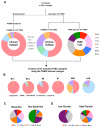Identification and use of biomarkers in treatment strategies for triple-negative breast cancer subtypes
- PMID: 24114677
- PMCID: PMC4090031
- DOI: 10.1002/path.4280
Identification and use of biomarkers in treatment strategies for triple-negative breast cancer subtypes
Abstract
Triple-negative breast cancer (TNBC) is a heterogeneous disease with distinct molecular subtypes that respond differentially to chemotherapy and targeted agents. The absence of high-frequency molecular alterations and a limited number of known biomarkers have limited the development of therapeutic strategies for the disease. Herein, we summarize the results of the first round of targeted therapy approaches in TNBC and discuss new preclinical strategies. Common themes emerge from the proposed strategies, such as the use of biomarkers to identify tumours with genomic instability, targeting adapted molecular states resulting from tumour suppressor loss, and targeting altered metabolic pathways.
Keywords: AR; EGFR; FGFR; INPP4B; LDHB; PHGDH; PIK3CA; PTEN; TNBCtype; TP53; VEGFR; WEE1; basal-like; genomic instability; subtypes; therapy; triple-negative breast cancer.
Copyright © 2013 Pathological Society of Great Britain and Ireland. Published by John Wiley & Sons, Ltd.
Figures

References
-
- Dent R, Trudeau M, Pritchard KI, Hanna WM, Kahn HK, Sawka CA, et al. Triple-negative breast cancer: clinical features and patterns of recurrence. Clinical Cancer Research. 2007 Aug 1;13(15 Pt 1):4429–34. - PubMed
-
- Carey LA, Dees EC, Sawyer L, Gatti L, Moore DT, Collichio F, et al. The triple negative paradox: primary tumor chemosensitivity of breast cancer subtypes. Clinical Cancer Research. 2007 Apr 15;13(8):2329–34. - PubMed
-
- Liedtke C, Mazouni C, Hess KR, André F, Tordai A, Mejia JA, et al. Response to neoadjuvant therapy and long-term survival in patients with triple-negative breast cancer. J. Clin. Oncol. 2008 Mar 10;26(8):1275–81. - PubMed
-
- Criscitiello C, Azim HA, Schouten PC, Linn SC, Sotiriou C. Understanding the biology of triple-negative breast cancer. Ann. Oncol. 2012 Aug;23(Suppl 6):vi13–8. - PubMed
Publication types
MeSH terms
Substances
Grants and funding
LinkOut - more resources
Full Text Sources
Other Literature Sources
Research Materials
Miscellaneous

